Magnetic Nanomaterials as Catalysts for Syngas Production and Conversion
Abstract
:1. Introduction
2. Magnetic Materials for Syngas Production/Conversion
3. Synthesis of Magnetic Nanomaterials
4. Syngas Production and Conversion
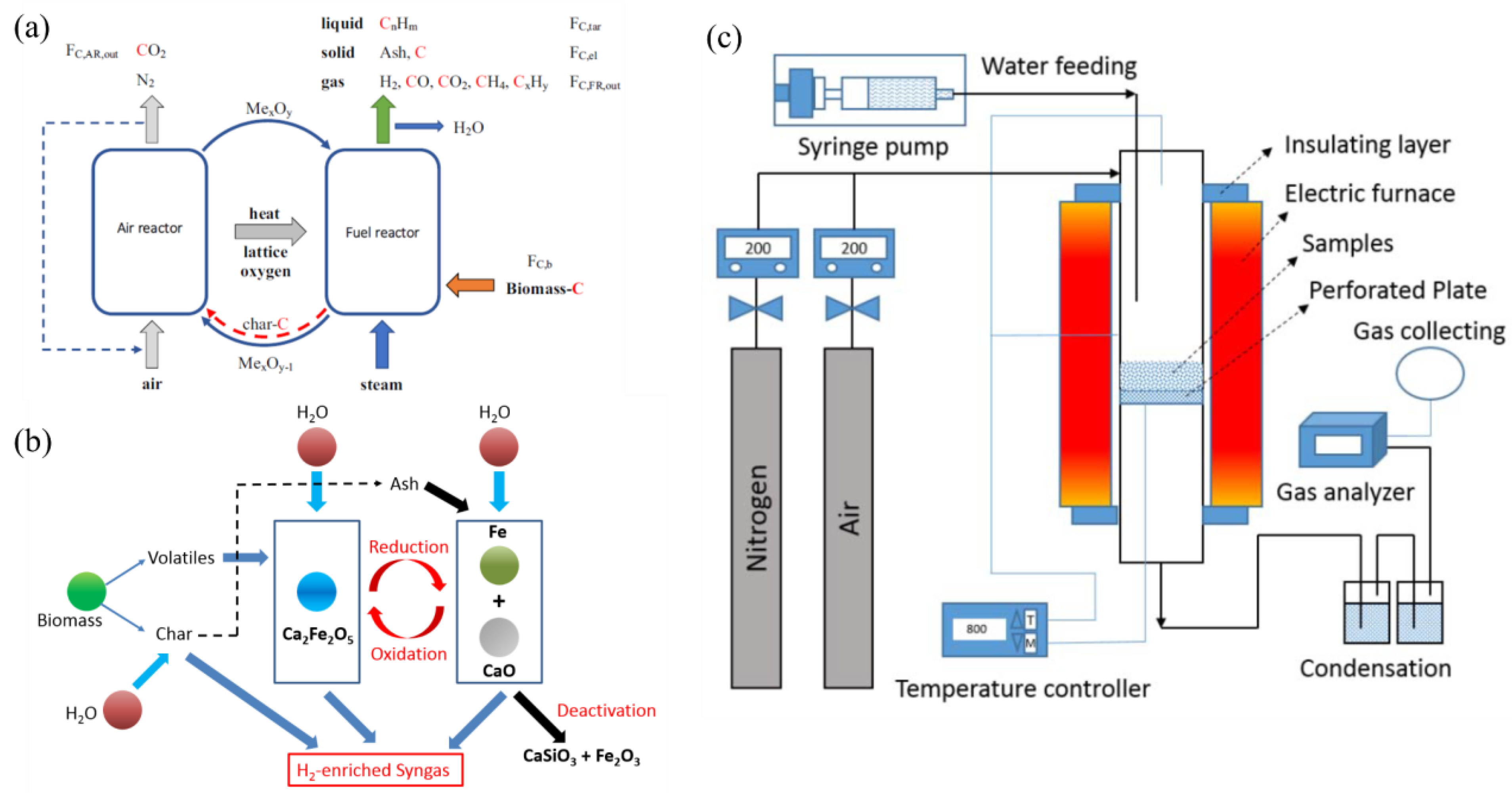
5. Tuning of Experimental Parameters
5.1. Temperature
5.2. pH
5.3. Catalyst Preparation Process
5.4. Pressure
6. Utilization of Magnetic Nanomaterials
6.1. Fe-Based Magnetic Materials
6.2. Ni-Based Materials
6.3. Co-Based MATERIALS
7. Effect of External Magnetic Field
8. Summary and Scope
Author Contributions
Funding
Data Availability Statement
Conflicts of Interest
References
- Hu, J.; Li, C.; Lee, D.-J.; Guo, Q.; Zhao, S.; Zhang, Q.; Li, D. Syngas Production from Biomass Using Fe-Based Oxygen Carrier: Optimization. Bioresour. Technol. 2019, 280, 183–187. [Google Scholar] [CrossRef]
- Ye, Z.; Yue, W.; Tayyab, M.; Zhang, J.; Zhang, J. Simple One-Pot, High-Yield Synthesis of 2D Graphitic Carbon Nitride Nanosheets for Photocatalytic Hydrogen Production. Dalton Trans. 2022, 51, 18542–18548. [Google Scholar] [CrossRef]
- Tayyab, M.; Liu, Y.; Liu, Z.; Xu, Z.; Yue, W.; Zhou, L.; Lei, J.; Zhang, J. A New Breakthrough in Photocatalytic Hydrogen Evolution by Amorphous and Chalcogenide Enriched Cocatalysts. Chem. Eng. J. 2023, 455, 140601. [Google Scholar] [CrossRef]
- Mohamedali, M.; Henni, A.; Ibrahim, H. Recent Advances in Supported Metal Catalysts for Syngas Production from Methane. ChemEngineering 2018, 2, 9. [Google Scholar] [CrossRef] [Green Version]
- Zhao, J.; Deng, J.; Han, J.; Imhanria, S.; Chen, K.; Wang, W. Effective Tunable Syngas Generation via CO2 Reduction Reaction by Non-Precious Fe-N-C Electrocatalyst. Chem. Eng. J. 2020, 389, 124323. [Google Scholar] [CrossRef]
- Kiatphuengporn, S.; Jantaratana, P.; Limtrakul, J.; Chareonpanich, M. Magnetic Field-Enhanced Catalytic CO 2 Hydrogenation and Selective Conversion to Light Hydrocarbons over Fe/MCM-41 Catalysts. Chem. Eng. J. 2016, 306, 866–875. [Google Scholar] [CrossRef]
- Lu, A.-H.; Salabas, E.L.; Schüth, F. Magnetic Nanoparticles: Synthesis, Protection, Functionalization, and Application. Angew. Chem. Int. Ed. 2007, 46, 1222–1244. [Google Scholar] [CrossRef]
- Liu, Y.; Tian, D.; Biswas, A.N.; Xie, Z.; Hwang, S.; Lee, J.H.; Meng, H.; Chen, J.G. Transition Metal Nitrides as Promising Catalyst Supports for Tuning CO/H2 Syngas Production from Electrochemical CO2 Reduction. Angew. Chem. Int. Ed. 2020, 59, 11345–11348. [Google Scholar] [CrossRef]
- Concha, B. CO Hydrogenation on Supported Molybdenum Catalysts: Effects of Support on Specific Activities of Reduced and Sulfided Catalysts. J. Catal. 1984, 89, 536–541. [Google Scholar] [CrossRef]
- Patterson, P. Carbon Monoxide Hydrogenation over Molybdenum and Tungsten Carbides. Appl. Catal. A Gen. 2003, 251, 449–455. [Google Scholar] [CrossRef]
- Vo, D.-V.N.; Cooper, C.G.; Nguyen, T.-H.; Adesina, A.A.; Bukur, D.B. Evaluation of Alumina-Supported Mo Carbide Produced via Propane Carburization for the Fischer–Tropsch Synthesis. Fuel 2012, 93, 105–116. [Google Scholar] [CrossRef]
- Zhu, X.; Wang, H.; Wei, Y.; Li, K.; Cheng, X. Hydrogen and Syngas Production from Two-Step Steam Reforming of Methane over CeO2-Fe2O3 Oxygen Carrier. J. Rare Earths 2010, 28, 907–913. [Google Scholar] [CrossRef]
- Deshpande, N.; Majumder, A.; Qin, L.; Fan, L.-S. High-Pressure Redox Behavior of Iron-Oxide-Based Oxygen Carriers for Syngas Generation from Methane. Energy Fuels 2015, 29, 1469–1478. [Google Scholar] [CrossRef]
- Mary, J.A.; Manikandan, A.; Kennedy, L.J.; Bououdina, M.; Sundaram, R.; Vijaya, J.J. Structure and Magnetic Properties of Cu-Ni Alloy Nanoparticles Prepared by Rapid Microwave Combustion Method. Trans. Nonferrous Met. Soc. China 2014, 24, 1467–1473. [Google Scholar] [CrossRef]
- Ray, K.; Sengupta, S.; Deo, G. Reforming and Cracking of CH4 over Al2O3 Supported Ni, Ni-Fe and Ni-Co Catalysts. Fuel Process. Technol. 2017, 156, 195–203. [Google Scholar] [CrossRef]
- Pudukudy, M.; Yaakob, Z.; Takriff, M.S. Methane Decomposition over Unsupported Mesoporous Nickel Ferrites: Effect of Reaction Temperature on the Catalytic Activity and Properties of the Produced Nanocarbon. RSC Adv. 2016, 6, 68081–68091. [Google Scholar] [CrossRef]
- Ali, B.; Tasirin, S.; Aminayi, P.; Yaakob, Z.; Ali, N.; Noori, W. Non-Supported Nickel-Based Coral Sponge-Like Porous Magnetic Alloys for Catalytic Production of Syngas and Carbon Bio-Nanofilaments via a Biogas Decomposition Approach. Nanomaterials 2018, 8, 1053. [Google Scholar] [CrossRef] [Green Version]
- Sengupta, S.; Ray, K.; Deo, G. Effects of Modifying Ni/Al2O3 Catalyst with Cobalt on the Reforming of CH4 with CO2 and Cracking of CH4 Reactions. Int. J. Hydrogen Energy 2014, 39, 11462–11472. [Google Scholar] [CrossRef]
- Li, D.; Koike, M.; Chen, J.; Nakagawa, Y.; Tomishige, K. Preparation of Ni–Cu/Mg/Al Catalysts from Hydrotalcite-like Compounds for Hydrogen Production by Steam Reforming of Biomass Tar. Int. J. Hydrogen Energy 2014, 39, 10959–10970. [Google Scholar] [CrossRef]
- Mizutani, N.; Iwasaki, T.; Watano, S.; Yanagida, T.; Kawai, T. Size Control of Magnetite Nanoparticles in Hydrothermal Synthesis by Coexistence of Lactate and Sulfate Ions. Curr. Appl. Phys. 2010, 10, 801–806. [Google Scholar] [CrossRef]
- Alayat, A.; Mcllroy, D.N.; McDonald, A.G. Effect of Synthesis and Activation Methods on the Catalytic Properties of Silica Nanospring (NS)-Supported Iron Catalyst for Fischer-Tropsch Synthesis. Fuel Process. Technol. 2018, 169, 132–141. [Google Scholar] [CrossRef]
- Ammar, S.; Fiévet, F. Polyol Synthesis: A Versatile Wet-Chemistry Route for the Design and Production of Functional Inorganic Nanoparticles. Nanomaterials 2020, 10, 1217. [Google Scholar] [CrossRef]
- Mosayebi, J.; Kiyasatfar, M.; Laurent, S. Synthesis, Functionalization, and Design of Magnetic Nanoparticles for Theranostic Applications. Adv. Healthc. Mater. 2017, 6, 1700306. [Google Scholar] [CrossRef]
- Ramalingam, V.; Harshavardhan, M.; Dinesh Kumar, S.; Malathi devi, S. Wet Chemical Mediated Hematite α-Fe2O3 Nanoparticles Synthesis: Preparation, Characterization and Anticancer Activity against Human Metastatic Ovarian Cancer. J. Alloy. Compd. 2020, 834, 155118. [Google Scholar] [CrossRef]
- Frimpong, R.A.; Dou, J.; Pechan, M.; Hilt, J.Z. Enhancing Remote Controlled Heating Characteristics in Hydrophilic Magnetite Nanoparticles via Facile Co-Precipitation. J. Magn. Magn. Mater. 2010, 322, 326–331. [Google Scholar] [CrossRef]
- Wang, H.; Dai, Y.Y.; Geng, D.Y.; Ma, S.; Li, D.; An, J.; He, J.; Liu, W.; Zhang, Z.D. CoxNi100−x Nanoparticles Encapsulated by Curved Graphite Layers: Controlled in Situ Metal-Catalytic Preparation and Broadband Microwave Absorption. Nanoscale 2015, 7, 17312–17319. [Google Scholar] [CrossRef]
- Jia, Q.; Ghoshal, S.; Li, J.; Liang, W.; Meng, G.; Che, H.; Zhang, S.; Ma, Z.-F.; Mukerjee, S. Metal and Metal Oxide Interactions and Their Catalytic Consequences for Oxygen Reduction Reaction. J. Am. Chem. Soc. 2017, 139, 7893–7903. [Google Scholar] [CrossRef]
- Zhou, X.; Shi, T.; Zhou, H. Hydrothermal Preparation of ZnO-Reduced Graphene Oxide Hybrid with High Performance in Photocatalytic Degradation. Appl. Surf. Sci. 2012, 258, 6204–6211. [Google Scholar] [CrossRef]
- Mizutani, N.; Iwasaki, T.; Watano, S.; Yanagida, T.; Tanaka, H.; Kawai, T. Effect of Ferrous/Ferric Ions Molar Ratio on Reaction Mechanism for Hydrothermal Synthesis of Magnetite Nanoparticles. Bull. Mater. Sci. 2008, 31, 713–717. [Google Scholar] [CrossRef] [Green Version]
- Zhang, Z.; Blom, D.A.; Gai, Z.; Thompson, J.R.; Shen, J.; Dai, S. High-Yield Solvothermal Formation of Magnetic CoPt Alloy Nanowires. J. Am. Chem. Soc. 2003, 125, 7528–7529. [Google Scholar] [CrossRef]
- Komarneni, S.; Roy, R.; Li, Q.H. Microwave-Hydrothermal Synthesis of Ceramic Powders. Mater. Res. Bull. 1992, 27, 1393–1405. [Google Scholar] [CrossRef]
- Li, J.; Wu, Q.; Wu, J. Synthesis of Nanoparticles via Solvothermal and Hydrothermal Methods. In Handbook of Nanoparticles; Aliofkhazraei, M., Ed.; Springer International Publishing: Cham, Switzerland, 2016; pp. 295–328. ISBN 978-3-319-15337-7. [Google Scholar]
- Roca, A.G.; Morales, M.P.; O’Grady, K.; Serna, C.J. Structural and Magnetic Properties of Uniform Magnetite Nanoparticles Prepared by High Temperature Decomposition of Organic Precursors. Nanotechnology 2006, 17, 2783–2788. [Google Scholar] [CrossRef]
- Bridgwater, A.V. Review of Fast Pyrolysis of Biomass and Product Upgrading. Biomass Bioenergy 2012, 38, 68–94. [Google Scholar] [CrossRef]
- Condori, O.; García-Labiano, F.; de Diego, L.F.; Izquierdo, M.T.; Abad, A.; Adánez, J. Biomass Chemical Looping Gasification for Syngas Production Using LD Slag as Oxygen Carrier in a 1.5 KWth Unit. Fuel Process. Technol. 2021, 222, 106963. [Google Scholar] [CrossRef]
- Palumbo, A.W.; Sorli, J.C.; Weimer, A.W. High Temperature Thermochemical Processing of Biomass and Methane for High Conversion and Selectivity to H2-Enriched Syngas. Appl. Energy 2015, 157, 13–24. [Google Scholar] [CrossRef]
- Hu, Q.; Shen, Y.; Chew, J.W.; Ge, T.; Wang, C.-H. Chemical Looping Gasification of Biomass with Fe2O3/CaO as the Oxygen Carrier for Hydrogen-Enriched Syngas Production. Chem. Eng. J. 2020, 379, 122346. [Google Scholar] [CrossRef]
- Liu, G.; Liao, Y.; Wu, Y.; Ma, X. Reactivity of Co-Doped Ca2Fe2O5 Brownmillerite Oxides as Oxygen Carriers for Microalgae Chemical Looping Gasification. Int. J. Hydrogen Energy 2019, 44, 2546–2559. [Google Scholar] [CrossRef]
- Zhang, J.; He, T.; Wang, Z.; Zhu, M.; Zhang, K.; Li, B.; Wu, J. The Search of Proper Oxygen Carriers for Chemical Looping Partial Oxidation of Carbon. Appl. Energy 2017, 190, 1119–1125. [Google Scholar] [CrossRef]
- Luo, M.; Wang, S.; Wang, L.; Lv, M. Reduction Kinetics of Iron-Based Oxygen Carriers Using Methane for Chemical-Looping Combustion. J. Power Sources 2014, 270, 434–440. [Google Scholar] [CrossRef]
- Chyou, Y.-P.; Chang, D.-M.; Chen, P.-C.; Chien, H.-Y.; Wu, K.-T.; Chein, R.-Y. Development of Biomass Gasification Technology with Fluidized-Bed Reactors for Enhancing Hydrogen Generation: Part I, Hydrodynamic Characterization of Dual Fluidized-Bed Gasifiers. Appl. Sci. 2019, 10, 2. [Google Scholar] [CrossRef] [Green Version]
- Paykani, A.; Khoshbakhti Saray, R.; Shervani-Tabar, M.T.; Mohammadi-Kousha, A. Effect of Exhaust Gas Recirculation and Intake Pre-Heating on Performance and Emission Characteristics of Dual Fuel Engines at Part Loads. J. Cent. South Univ. Technol. 2012, 19, 1346–1352. [Google Scholar] [CrossRef]
- Fiore, M.; Magi, V.; Viggiano, A. Internal Combustion Engines Powered by Syngas: A Review. Appl. Energy 2020, 276, 115415. [Google Scholar] [CrossRef]
- Lu, J.-S.; Chang, Y.; Poon, C.-S.; Lee, D.-J. Slow Pyrolysis of Municipal Solid Waste (MSW): A Review. Bioresour. Technol. 2020, 312, 123615. [Google Scholar] [CrossRef]
- Kianfar, E. Catalytic Properties of Nanomaterials and Factors Affecting It. In Importance & Applications of Nanotechnology; MedDocs: Reno, NV, USA, 2020; Volume 5, pp. 22–25. [Google Scholar]
- Kianfar, E.; Pirouzfar, V.; Sakhaeinia, H. An Experimental Study on Absorption/Stripping CO2 Using Mono-Ethanol Amine Hollow Fiber Membrane Contactor. J. Taiwan Inst. Chem. Eng. 2017, 80, 954–962. [Google Scholar] [CrossRef]
- Kozhushner, M.A.; Trakhtenberg, L.I.; Bodneva, V.L.; Belisheva, T.V.; Landerville, A.C.; Oleynik, I.I. Effect of Temperature and Nanoparticle Size on Sensor Properties of Nanostructured Tin Dioxide Films. J. Phys. Chem. C 2014, 118, 11440–11444. [Google Scholar] [CrossRef]
- Vijayaraghavan, K.; Ashokkumar, T. Plant-Mediated Biosynthesis of Metallic Nanoparticles: A Review of Literature, Factors Affecting Synthesis, Characterization Techniques and Applications. J. Environ. Chem. Eng. 2017, 5, 4866–4883. [Google Scholar] [CrossRef]
- Yang, S.; Zhang, X.; Chen, L.; Sun, L.; Xie, X.; Zhao, B. Production of Syngas from Pyrolysis of Biomass Using Fe/CaO Catalysts: Effect of Operating Conditions on the Process. J. Anal. Appl. Pyrolysis 2017, 125, 1–8. [Google Scholar] [CrossRef]
- Marciniak, L.; Nowak, M.; Trojanowska, A.; Tylkowski, B.; Jastrzab, R. The Effect of PH on the Size of Silver Nanoparticles Obtained in the Reduction Reaction with Citric and Malic Acids. Materials 2020, 13, 5444. [Google Scholar] [CrossRef]
- Karim, N.A.; Rubinsin, N.J.; Burukan, M.A.A.; Kamarudin, S.K. Sustainable Route of Synthesis Platinum Nanoparticles Using Orange Peel Extract. Int. J. Green Energy 2019, 16, 1518–1526. [Google Scholar] [CrossRef]
- Jameel, M.S.; Aziz, A.A.; Dheyab, M.A. Green Synthesis: Proposed Mechanism and Factors Influencing the Synthesis of Platinum Nanoparticles. Green Process. Synth. 2020, 9, 386–398. [Google Scholar] [CrossRef]
- Fakhroueian, Z.; Esmaeilzadeh, P.; Afroukhteh Langroudi, N.; Varmazyar, H.; Ahmadirad, M.; Zadeh, P.E.; Yousefi, M.; Karami, M.; Shafiekhani, A.; Sepehriseresht, S. Influence of Important Nanoemulsions PH on Performance of Nanostructures Catalysts for H2 Production in Syngas Reactions. Defect Diffus. Forum 2011, 312–315, 20–26. [Google Scholar] [CrossRef]
- Thakur, A.; Kumar, A.; Kaya, S.; Vo, D.-V.N.; Sharma, A. Suppressing Inhibitory Compounds by Nanomaterials for Highly Efficient Biofuel Production: A Review. Fuel 2022, 312, 122934. [Google Scholar] [CrossRef]
- Rane, A.V.; Kanny, K.; Abitha, V.K.; Thomas, S. Methods for Synthesis of Nanoparticles and Fabrication of Nanocomposites. In Synthesis of Inorganic Nanomaterials; Elsevier: Amsterdam, The Netherlands, 2018; pp. 121–139. ISBN 978-0-08-101975-7. [Google Scholar]
- Devi, A.; Singh, A.; Bajar, S.; Owamah, H.I. Nanomaterial in Liquid Biofuel Production: Applications and Current Status. Environ. Sustain. 2021, 4, 343–353. [Google Scholar] [CrossRef]
- Thangavelu, S.K.; Ahmed, A.S.; Ani, F.N. Impact of Metals on Corrosive Behavior of Biodiesel–Diesel–Ethanol (BDE) Alternative Fuel. Renew. Energy 2016, 94, 1–9. [Google Scholar] [CrossRef]
- Xu, C.; Chen, S.; Soomro, A.; Sun, Z.; Xiang, W. Hydrogen Rich Syngas Production from Biomass Gasification Using Synthesized Fe/CaO Active Catalysts. J. Energy Inst. 2018, 91, 805–816. [Google Scholar] [CrossRef]
- Han, T.; Zhao, L.; Liu, G.; Ning, H.; Yue, Y.; Liu, Y. Rh-Fe Alloy Derived from YRh0.5Fe0.5O3/ZrO2 for Higher Alcohols Synthesis from Syngas. Catal. Today 2017, 298, 69–76. [Google Scholar] [CrossRef]
- Smitshuysen, T.E.L.; Nielsen, M.R.; Pruessmann, T.; Zimina, A.; Sheppard, T.L.; Grunwaldt, J.; Chorkendorff, I.; Damsgaard, C.D. Optimizing Ni−Fe−Ga Alloys into Ni2 FeGa for the Hydrogenation of CO2 into Methanol. ChemCatChem 2020, 12, 3265–3273. [Google Scholar] [CrossRef]
- Li, K.; Wang, H.; Wei, Y. Syngas Generation from Methane Using a Chemical-Looping Concept: A Review of Oxygen Carriers. J. Chem. 2013, 2013, 294817. [Google Scholar] [CrossRef] [Green Version]
- Adánez-Rubio, I.; Bautista, H.; Izquierdo, M.T.; Gayán, P.; Abad, A.; Adánez, J. Development of a Magnetic Cu-Based Oxygen Carrier for the Chemical Looping with Oxygen Uncoupling (CLOU) Process. Fuel Process. Technol. 2021, 218, 106836. [Google Scholar] [CrossRef]
- Pérez-Vega, R.; Abad, A.; García-Labiano, F.; Gayán, P.; de Diego, L.F.; Izquierdo, M.T.; Adánez, J. Chemical Looping Combustion of Gaseous and Solid Fuels with Manganese-Iron Mixed Oxide as Oxygen Carrier. Energy Convers. Manag. 2018, 159, 221–231. [Google Scholar] [CrossRef]
- Cara, C.; Mameli, V.; Rombi, E.; Pinna, N.; Sanna Angotzi, M.; Nižňanský, D.; Musinu, A.; Cannas, C. Anchoring Ultrasmall FeIII-Based Nanoparticles on Silica and Titania Mesostructures for Syngas H2S Purification. Microporous Mesoporous Mater. 2020, 298, 110062. [Google Scholar] [CrossRef]
- Pankina, G.V.; Shumyantsev, A.V.; Chernyak, S.A.; Lunin, V.V. Influence of Structural Properties of Support on the Activation of Fe–K/MgAl2O4 Catalysts in Syngas. Kinet. Catal. 2019, 60, 672–680. [Google Scholar] [CrossRef]
- Kwon, G.; Cho, D.-W.; Kwon, E.E.; Rinklebe, J.; Wang, H.; Song, H. Beneficial Use of Fe-Impregnated Bentonite as a Catalyst for Pyrolysis of Grass Cut into Syngas, Bio-Oil and Biochar. Chem. Eng. J. 2022, 448, 137502. [Google Scholar] [CrossRef]
- San, X.; Cui, J.; Chu, Y.; Xu, J.; Meng, D.; Pan, Z.; Wang, G.; Qi, J.; Jin, Q. New Design and Construction of Hierarchical Porous Ni/SiO2 Catalyst with Anti-sintering and Carbon Deposition Ability for Dry Reforming of Methane. ChemistrySelect 2022, 7, e202202258. [Google Scholar] [CrossRef]
- Saad, J.M.; Nahil, M.A.; Wu, C.; Williams, P.T. Influence of Nickel-Based Catalysts on Syngas Production from Carbon Dioxide Reforming of Waste High Density Polyethylene. Fuel Process. Technol. 2015, 138, 156–163. [Google Scholar] [CrossRef]
- Du, X.; Zhang, D.; Gao, R.; Huang, L.; Shi, L.; Zhang, J. Design of Modular Catalysts Derived from NiMgAl-LDH@m-SiO2 with Dual Confinement Effects for Dry Reforming of Methane. Chem. Commun. 2013, 49, 6770. [Google Scholar] [CrossRef]
- Yusuf, M.; Farooqi, A.S.; Al-Kahtani, A.A.; Ubaidullah, M.; Alam, M.A.; Keong, L.K.; Hellgardt, K.; Abdullah, B. Syngas Production from Greenhouse Gases Using Ni–W Bimetallic Catalyst via Dry Methane Reforming: Effect of W Addition. Int. J. Hydrogen Energy 2021, 46, 27044–27061. [Google Scholar] [CrossRef]
- Deng, J.; Liu, Z.; Qin, T.; Chen, X.; Li, K.; Meng, L.; Zhao, Y.; Zhou, Y.; Yuan, S. Development of Ni-Doped Fe/Ca Catalyst to Be Used for Hydrogen-Rich Syngas Production during Medicine Residue Pyrolysis. Energy 2022, 254, 124205. [Google Scholar] [CrossRef]
- Raberg, L.; Jensen, M.; Olsbye, U.; Daniel, C.; Haag, S.; Mirodatos, C.; Sjastad, A. Propane Dry Reforming to Synthesis Gas over Ni-Based Catalysts: Influence of Support and Operating Parameters on Catalyst Activity and Stability. J. Catal. 2007, 249, 250–260. [Google Scholar] [CrossRef]
- Tsodikov, M.V.; Ellert, O.G.; Nikolaev, S.A.; Arapova, O.V.; Konstantinov, G.I.; Bukhtenko, O.V.; Vasil’kov, A.Y. The Role of Nanosized Nickel Particles in Microwave-Assisted Dry Reforming of Lignin. Chem. Eng. J. 2017, 309, 628–637. [Google Scholar] [CrossRef]
- Gai, C.; Zhu, N.; Hoekman, S.K.; Liu, Z.; Jiao, W.; Peng, N. Highly Dispersed Nickel Nanoparticles Supported on Hydrochar for Hydrogen-Rich Syngas Production from Catalytic Reforming of Biomass. Energy Convers. Manag. 2019, 183, 474–484. [Google Scholar] [CrossRef]
- Li, Z.; Kathiraser, Y.; Ashok, J.; Oemar, U.; Kawi, S. Simultaneous Tuning Porosity and Basicity of Nickel@Nickel–Magnesium Phyllosilicate Core–Shell Catalysts for CO2 Reforming of CH4. Langmuir 2014, 30, 14694–14705. [Google Scholar] [CrossRef]
- Wang, H.; Mao, D.; Qi, J.; Zhang, Q.; Ma, X.; Song, S.; Gu, L.; Yu, R.; Wang, D. Hollow Multishelled Structure of Heterogeneous Co3O4–CeO2−x Nanocomposite for CO Catalytic Oxidation. Adv. Funct. Mater. 2019, 29, 1806588. [Google Scholar] [CrossRef]
- Prieto, G.; Beijer, S.; Smith, M.L.; He, M.; Au, Y.; Wang, Z.; Bruce, D.A.; de Jong, K.P.; Spivey, J.J.; de Jongh, P.E. Design and Synthesis of Copper–Cobalt Catalysts for the Selective Conversion of Synthesis Gas to Ethanol and Higher Alcohols. Angew. Chem. Int. Ed. 2014, 53, 6397–6401. [Google Scholar] [CrossRef]
- Zhang, R.; Liu, F.; Wang, B. Co-Decorated Cu Alloy Catalyst for C2 Oxygenate and Ethanol Formation from Syngas on Cu-Based Catalyst: Insight into the Role of Co and Cu as Well as the Improved Selectivity. Catal. Sci. Technol. 2016, 6, 8036–8054. [Google Scholar] [CrossRef]
- Nguyen, H.M.; Phan, C.M.; Liu, S.; Pham-Huu, C.; Nguyen-Dinh, L. Radio-Frequency Induction Heating Powered Low-Temperature Catalytic CO2 Conversion via Bi-Reforming of Methane. Chem. Eng. J. 2022, 430, 132934. [Google Scholar] [CrossRef]
- Chen, L.; Zhu, Q.; Hao, Z.; Zhang, T.; Xie, Z. Development of a Co–Ni Bimetallic Aerogel Catalyst for Hydrogen Production via Methane Oxidative CO2 Reforming in a Magnetic Assisted Fluidized Bed. Int. J. Hydrogen Energy 2010, 35, 8494–8502. [Google Scholar] [CrossRef]
- Liang, D.; Wang, Y.; Chen, M.; Xie, X.; Li, C.; Wang, J.; Yuan, L. Dry Reforming of Methane for Syngas Production over Attapulgite-Derived MFI Zeolite Encapsulated Bimetallic Ni-Co Catalysts. Appl. Catal. B Environ. 2023, 322, 122088. [Google Scholar] [CrossRef]
- Daiyan, R.; Chen, R.; Kumar, P.; Bedford, N.M.; Qu, J.; Cairney, J.M.; Lu, X.; Amal, R. Tunable Syngas Production through CO2 Electroreduction on Cobalt–Carbon Composite Electrocatalyst. ACS Appl. Mater. Interfaces 2020, 12, 9307–9315. [Google Scholar] [CrossRef]
- Alaei, S.; Haghighi, M.; Toghiani, J.; Rahmani Vahid, B. Magnetic and Reusable MgO/MgFe2O4 Nanocatalyst for Biodiesel Production from Sunflower Oil: Influence of Fuel Ratio in Combustion Synthesis on Catalytic Properties and Performance. Ind. Crops Prod. 2018, 117, 322–332. [Google Scholar] [CrossRef]
- Lan, P.-W.; Wang, C.-C.; Chen, C.-Y. Effect of Ni/Fe Ratio in Ni–Fe Catalysts Prepared under External Magnetic Field on CO2 Methanation. J. Taiwan Inst. Chem. Eng. 2021, 127, 166–174. [Google Scholar] [CrossRef]
- Guo, F.; Li, X.; Liu, Y.; Peng, K.; Guo, C.; Rao, Z. Catalytic Cracking of Biomass Pyrolysis Tar over Char-Supported Catalysts. Energy Convers. Manag. 2018, 167, 81–90. [Google Scholar] [CrossRef]
- Han, T.; Yang, W.; Jönsson, P.G. Pyrolysis and Subsequent Steam Gasification of Metal Dry Impregnated Lignin for the Production of H2-Rich Syngas and Magnetic Activated Carbon. Chem. Eng. J. 2020, 394, 124902. [Google Scholar] [CrossRef]
- Gao, Y.; Jiang, J.; Meng, Y.; Aihemaiti, A.; Ju, T.; Chen, X.; Yan, F. A Novel Nickel Catalyst Supported on Activated Coal Fly Ash for Syngas Production via Biogas Dry Reforming. Renew. Energy 2020, 149, 786–793. [Google Scholar] [CrossRef]
- Zhu, M.; Song, Y.; Chen, S.; Li, M.; Zhang, L.; Xiang, W. Chemical Looping Dry Reforming of Methane with Hydrogen Generation on Fe2O3/Al2O3 Oxygen Carrier. Chem. Eng. J. 2019, 368, 812–823. [Google Scholar] [CrossRef]
- Hsieh, P.-H.; Lai, Y.-C.; Chen, K.-Y.; Hung, C.-H. Explore the Possible Effect of TiO2 and Magnetic Hematite Nanoparticle Addition on Biohydrogen Production by Clostridium Pasteurianum Based on Gene Expression Measurements. Int. J. Hydrogen Energy 2016, 41, 21685–21691. [Google Scholar] [CrossRef]
- Zhu, L.-D.; Hiltunen, E.; Li, Z. Using Magnetic Materials to Harvest Microalgal Biomass: Evaluation of Harvesting and Detachment Efficiency. Environ. Technol. 2019, 40, 1006–1012. [Google Scholar] [CrossRef]
- Ghasemi, H.; Aghabarari, B.; Alizadeh, M.; Khanlarkhani, A.; Abu-Zahra, N. High Efficiency Decolorization of Wastewater by Fenton Catalyst: Magnetic Iron-Copper Hybrid Oxides. J. Water Process Eng. 2020, 37, 101540. [Google Scholar] [CrossRef]
- Yang, S.; Chen, L.; Sun, L.; Xie, X.; Zhao, B.; Si, H.; Zhang, X.; Hua, D. Novel Ni–Al Nanosheet Catalyst with Homogeneously Embedded Nickel Nanoparticles for Hydrogen-Rich Syngas Production from Biomass Pyrolysis. Int. J. Hydrogen Energy 2021, 46, 1762–1776. [Google Scholar] [CrossRef]
- Guo, F.; Liang, S.; Zhao, X.; Jia, X.; Peng, K.; Jiang, X.; Qian, L. Catalytic Reforming of Biomass Pyrolysis Tar Using the Low-Cost Steel Slag as Catalyst. Energy 2019, 189, 116161. [Google Scholar] [CrossRef]
- Zhang, X.; Yang, S.; Xie, X.; Chen, L.; Sun, L.; Zhao, B.; Si, H. Stoichiometric Synthesis of Fe/CaxO Catalysts from Tailored Layered Double Hydroxide Precursors for Syngas Production and Tar Removal in Biomass Gasification. J. Anal. Appl. Pyrolysis 2016, 120, 371–378. [Google Scholar] [CrossRef]
- Yan, M.; Liu, J.; Hantoko, D.; Kanchanatip, E.; Grisdanurak, N.; Cai, Y.; Gao, Z. Hydrogen-Rich Syngas Production by Catalytic Cracking of Tar in Wastewater under Supercritical Condition. Int. J. Hydrogen Energy 2019, 44, 19908–19919. [Google Scholar] [CrossRef]
- Khzouz, M.; Gkanas, E.I.; Du, S.; Wood, J. Catalytic Performance of Ni-Cu/Al2O3 for Effective Syngas Production by Methanol Steam Reforming. Fuel 2018, 232, 672–683. [Google Scholar] [CrossRef]
- Liang, S.; Guo, F.; Du, S.; Tian, B.; Dong, Y.; Jia, X.; Qian, L. Synthesis of Sargassum Char-Supported Ni-Fe Nanoparticles and Its Application in Tar Cracking during Biomass Pyrolysis. Fuel 2020, 275, 117923. [Google Scholar] [CrossRef]
- Zhang, S.; Zhu, S.; Zhang, H.; Liu, X.; Xiong, Y. High Quality H2-Rich Syngas Production from Pyrolysis-Gasification of Biomass and Plastic Wastes by Ni–Fe@Nanofibers/Porous Carbon Catalyst. Int. J. Hydrogen Energy 2019, 44, 26193–26203. [Google Scholar] [CrossRef]
- Park, S.Y.; Oh, G.; Kim, K.; Seo, M.W.; Ra, H.W.; Mun, T.Y.; Lee, J.G.; Yoon, S.J. Deactivation Characteristics of Ni and Ru Catalysts in Tar Steam Reforming. Renew. Energy 2017, 105, 76–83. [Google Scholar] [CrossRef]
- Khavryuchenko, O.V.; Khavryuchenko, V.D.; Su, D. Spin Catalysts: A Quantum Trigger for Chemical Reactions. Chin. J. Catal. 2015, 36, 1656–1661. [Google Scholar] [CrossRef]
- Bhattacharyya, K.; Chowdhury, M. Environmental and Magnetic Field Effects on Exciplex and Twisted Charge Transfer Emission. Chem. Rev. 1993, 93, 507–535. [Google Scholar] [CrossRef]
- Jiang, X.; Chen, Y.; Zhang, X.; You, F.; Yao, J.; Yang, H.; Xia, B.Y. Magnetic Field-Assisted Construction and Enhancement of Electrocatalysts. ChemSusChem 2022, 15, e202201551. [Google Scholar] [CrossRef]
- Jiang, M.-P.; Huang, K.-K.; Liu, J.-H.; Wang, D.; Wang, Y.; Wang, X.; Li, Z.-D.; Wang, X.-Y.; Geng, Z.-B.; Hou, X.-Y.; et al. Magnetic-Field-Regulated TiO2 {100} Facets: A Strategy for C-C Coupling in CO2 Photocatalytic Conversion. Chem 2020, 6, 2335–2346. [Google Scholar] [CrossRef]
- Kodaimati, M.S.; Gao, R.; Root, S.E.; Whitesides, G.M. Magnetic Fields Enhance Mass Transport during Electrocatalytic Reduction of CO2. Chem Catal. 2022, 2, 797–815. [Google Scholar] [CrossRef]
- Zhao, X.; Liang, H.; Chen, Y.; Chen, X.; Zhang, W.; Wang, J.; Zhang, G.; Belotelov, V.I.; Song, Y. Magnetic Field Coupling Microfluidic Synthesis of Diluted Magnetic Semiconductor Quantum Dots: The Case of Co Doping ZnSe Quantum Dots. J. Mater. Chem. C 2021, 9, 4619–4627. [Google Scholar] [CrossRef]
- Wang, J.; Song, Y. Magnetic Field Coupling Microfluidic Synthesis of Fe2Pt/C Nanocatalysts for Enhanced Electrochemical Catalytic Oxidation of Alcohol. Int. J. Hydrogen Energy 2020, 45, 13035–13044. [Google Scholar] [CrossRef]
- He, Z.; Yu, S.-H.; Zhou, X.; Li, X.; Qu, J. Magnetic-Field-Induced Phase-Selective Synthesis of Ferrosulfide Microrods by a Hydrothermal Process: Microstructure Control and Magnetic Properties. Adv. Funct. Mater. 2006, 16, 1105–1111. [Google Scholar] [CrossRef]
- Garcés-Pineda, F.A.; Blasco-Ahicart, M.; Nieto-Castro, D.; López, N.; Galán-Mascarós, J.R. Direct Magnetic Enhancement of Electrocatalytic Water Oxidation in Alkaline Media. Nat. Energy 2019, 4, 519–525. [Google Scholar] [CrossRef] [Green Version]
- Kim, Y.-K.; Lee, H. Use of Magnetic Nanoparticles to Enhance Bioethanol Production in Syngas Fermentation. Bioresour. Technol. 2016, 204, 139–144. [Google Scholar] [CrossRef]
- Xie, Y.; Wang, M.; Wang, X.; Wang, L.; Ning, P.; Ma, Y.; Lu, J.; Cao, R.; Xue, Y. Magnetic-Field-Assisted Catalytic Oxidation of Arsine over Fe/HZSM-5 Catalyst: Synergistic Effect of Fe Species and Activated Surface Oxygen. J. Clean. Prod. 2022, 337, 130549. [Google Scholar] [CrossRef]
- Zhao, B.; Yang, H.; Zhang, H.; Zhong, C.; Wang, J.; Zhu, D.; Guan, H.; Sun, L.; Yang, S.; Chen, L.; et al. Study on Hydrogen-Rich Gas Production by Biomass Catalytic Pyrolysis Assisted with Magnetic Field. J. Anal. Appl. Pyrolysis 2021, 157, 105227. [Google Scholar] [CrossRef]
- Sriakkarin, C.; Umchoo, W.; Donphai, W.; Poo-arporn, Y.; Chareonpanich, M. Sustainable Production of Methanol from CO2 over 10Cu-10Fe/ZSM-5 Catalyst in a Magnetic Field-Assisted Packed Bed Reactor. Catal. Today 2018, 314, 114–121. [Google Scholar] [CrossRef]
- Donphai, W.; Piriyawate, N.; Witoon, T.; Jantaratana, P.; Varabuntoonvit, V.; Chareonpanich, M. Effect of Magnetic Field on CO2 Conversion over Cu-ZnO/ZrO2 Catalyst in Hydrogenation Reaction. J. CO2 Util. 2016, 16, 204–211. [Google Scholar] [CrossRef]
- Pan, H.; Jiang, X.; Wang, X.; Wang, Q.; Wang, M.; Shen, Y. Effective Magnetic Field Regulation of the Radical Pair Spin States in Electrocatalytic CO2 Reduction. J. Phys. Chem. Lett. 2020, 11, 48–53. [Google Scholar] [CrossRef]
- Li, J.; Li, J.; Zhu, Q.; Li, H. Magnetic Field Acceleration of CO2 Reforming of Methane over Novel Hierarchical Co/MgO Catalyst in Fluidized Bed Reactor. Chem. Eng. J. 2018, 350, 496–506. [Google Scholar] [CrossRef]
- Li, J.; Zhou, L.; Zhu, Q.; Li, H. Enhanced Methanation over Aerogel NiCo/Al2O3 Catalyst in a Magnetic Fluidized Bed. Ind. Eng. Chem. Res. 2013, 52, 6647–6654. [Google Scholar] [CrossRef]
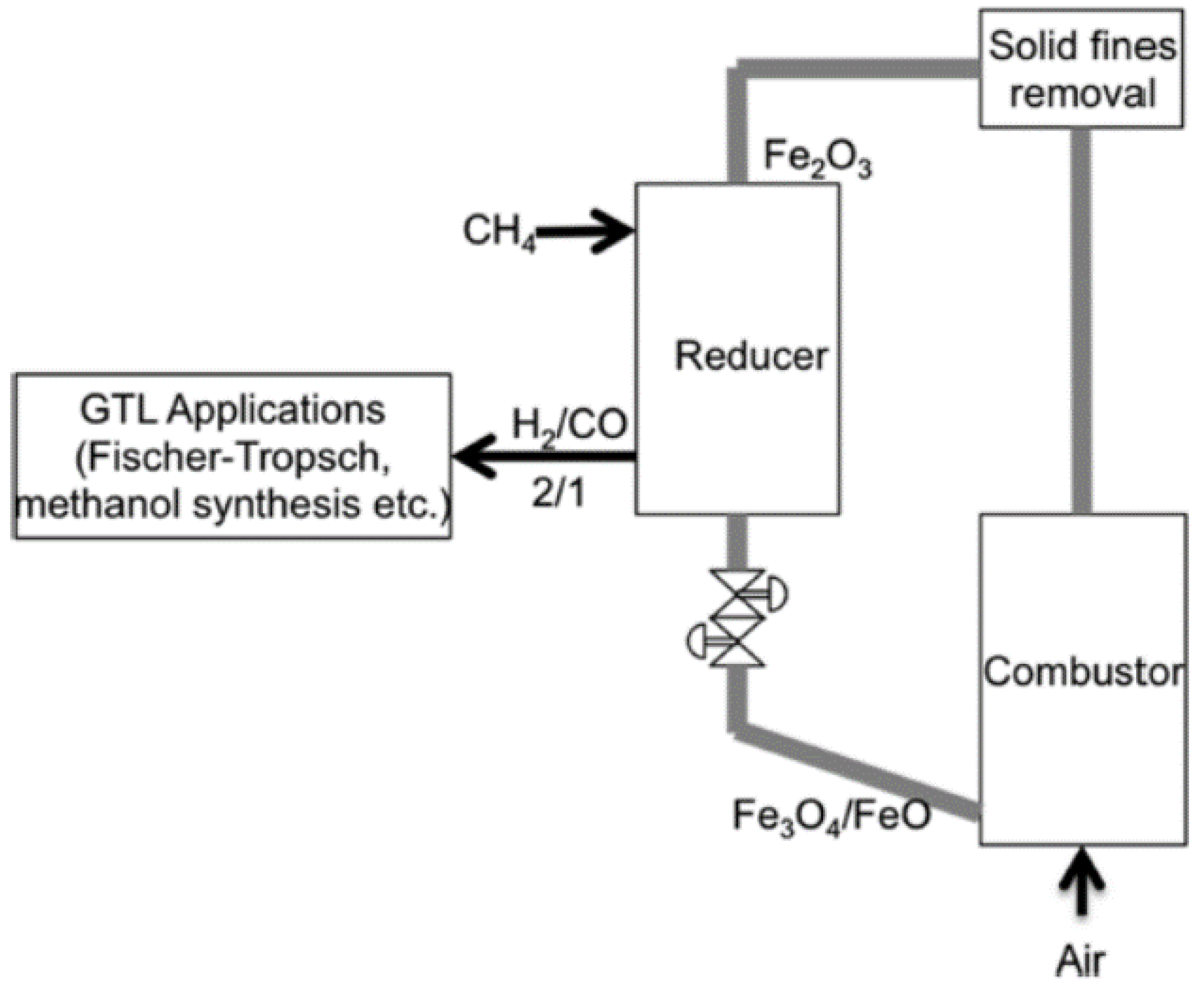
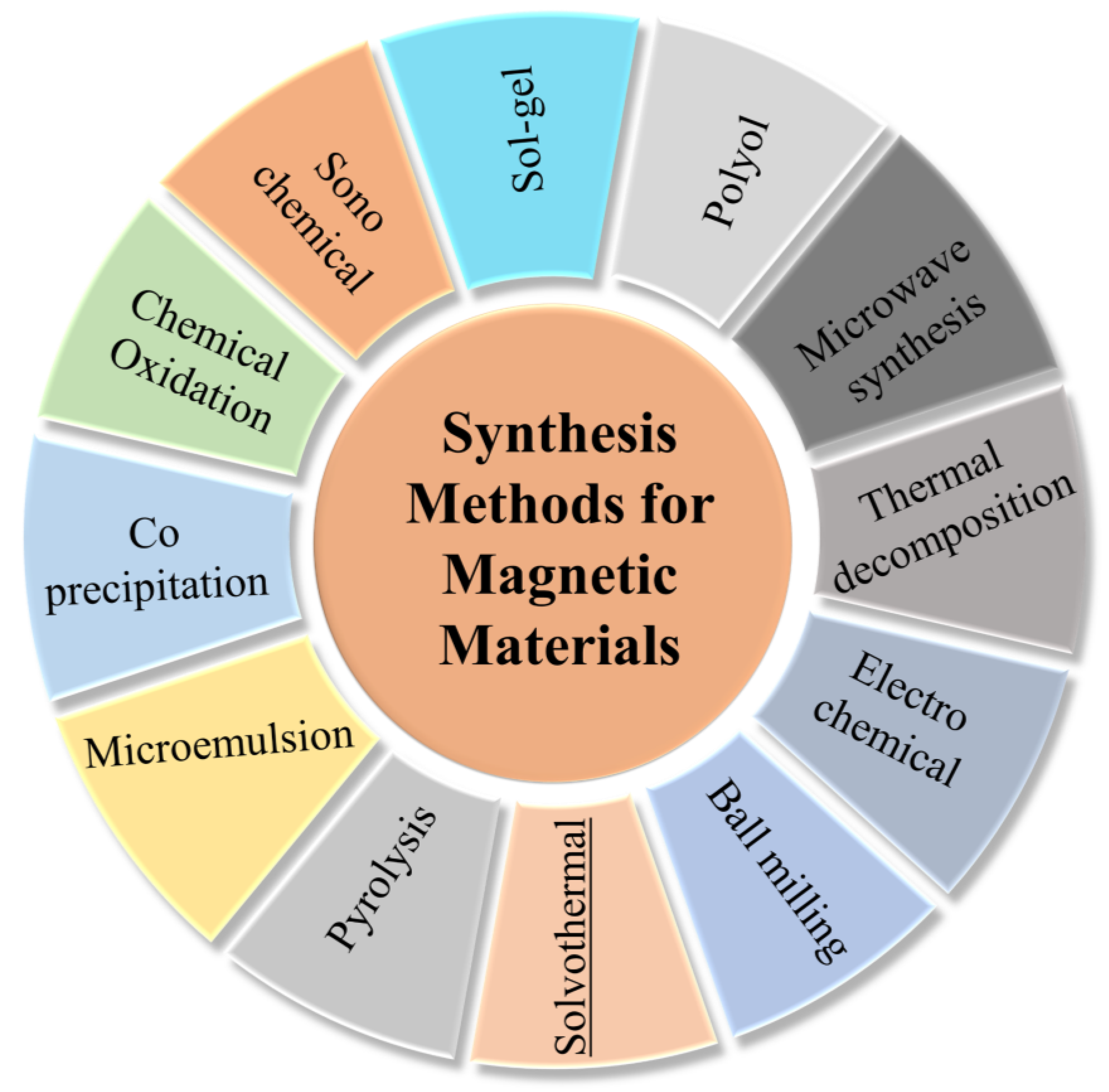


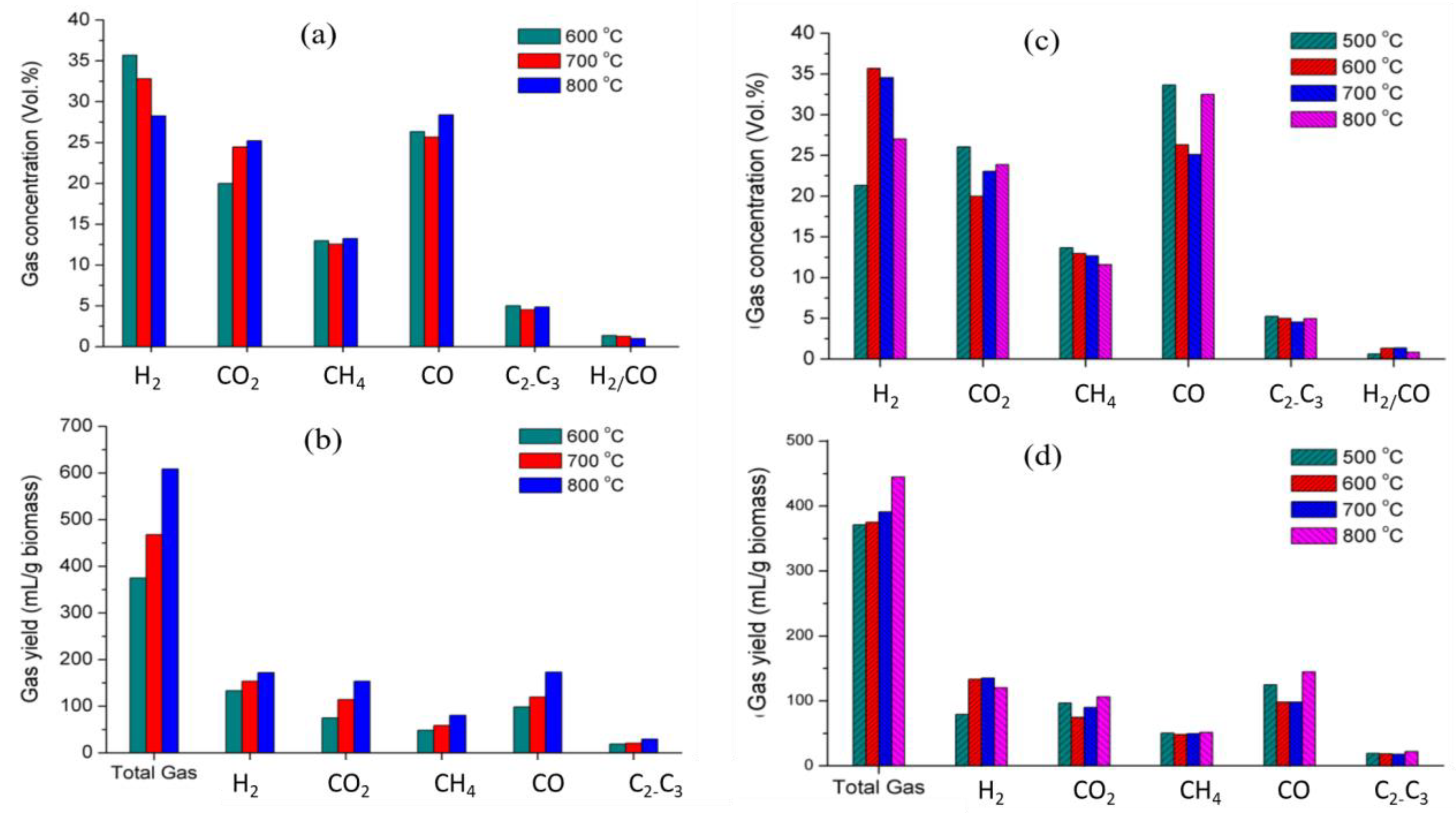


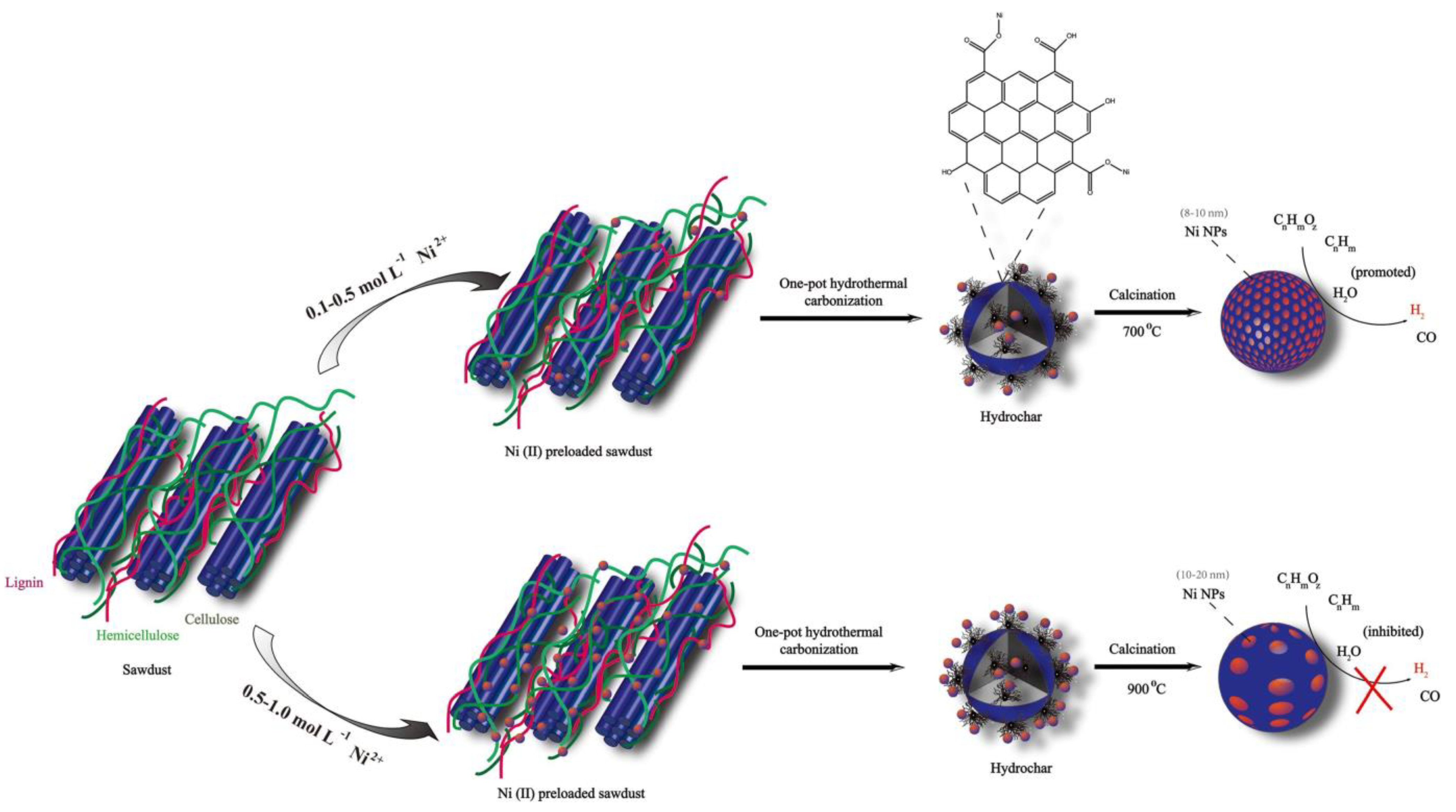

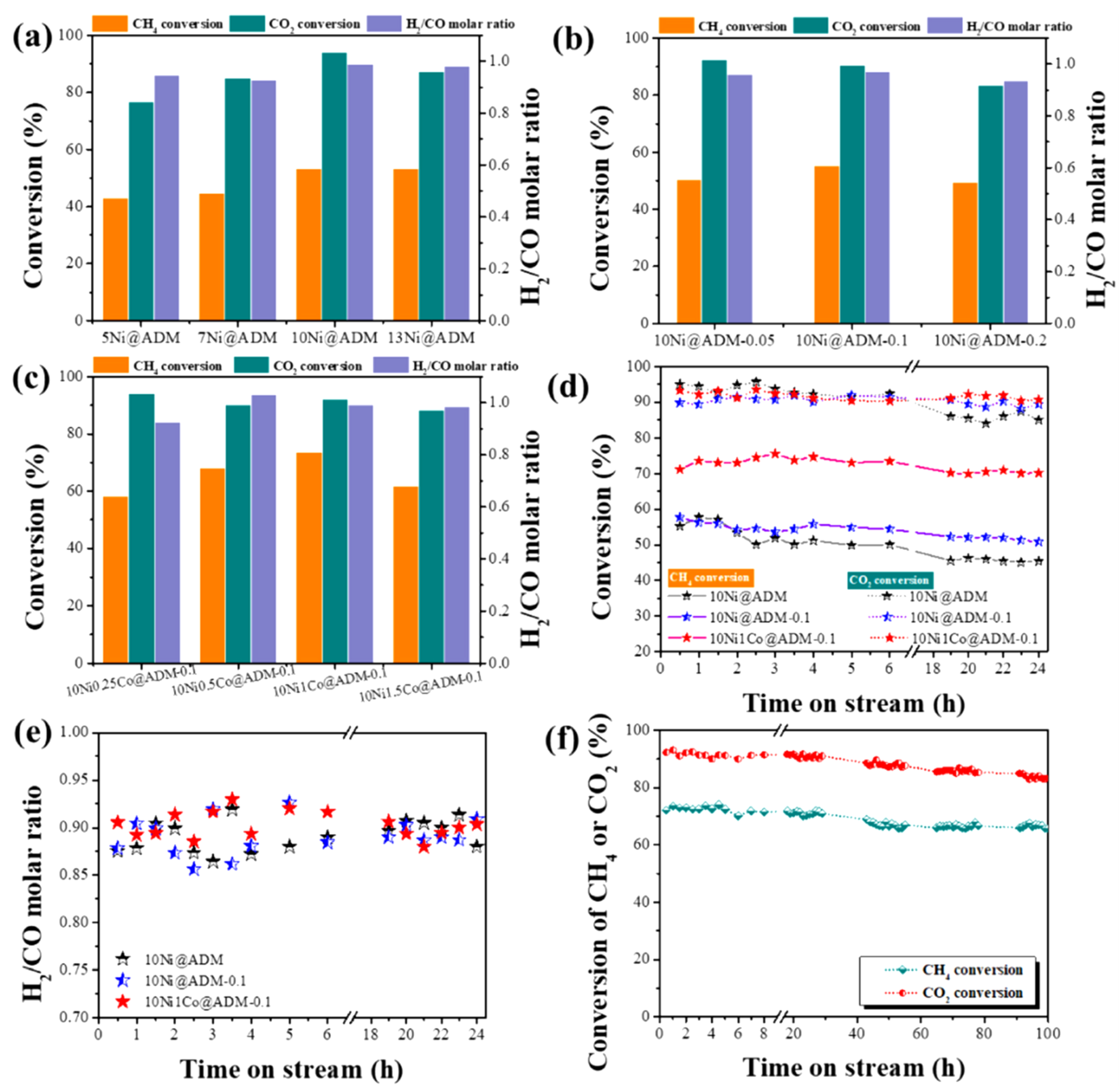
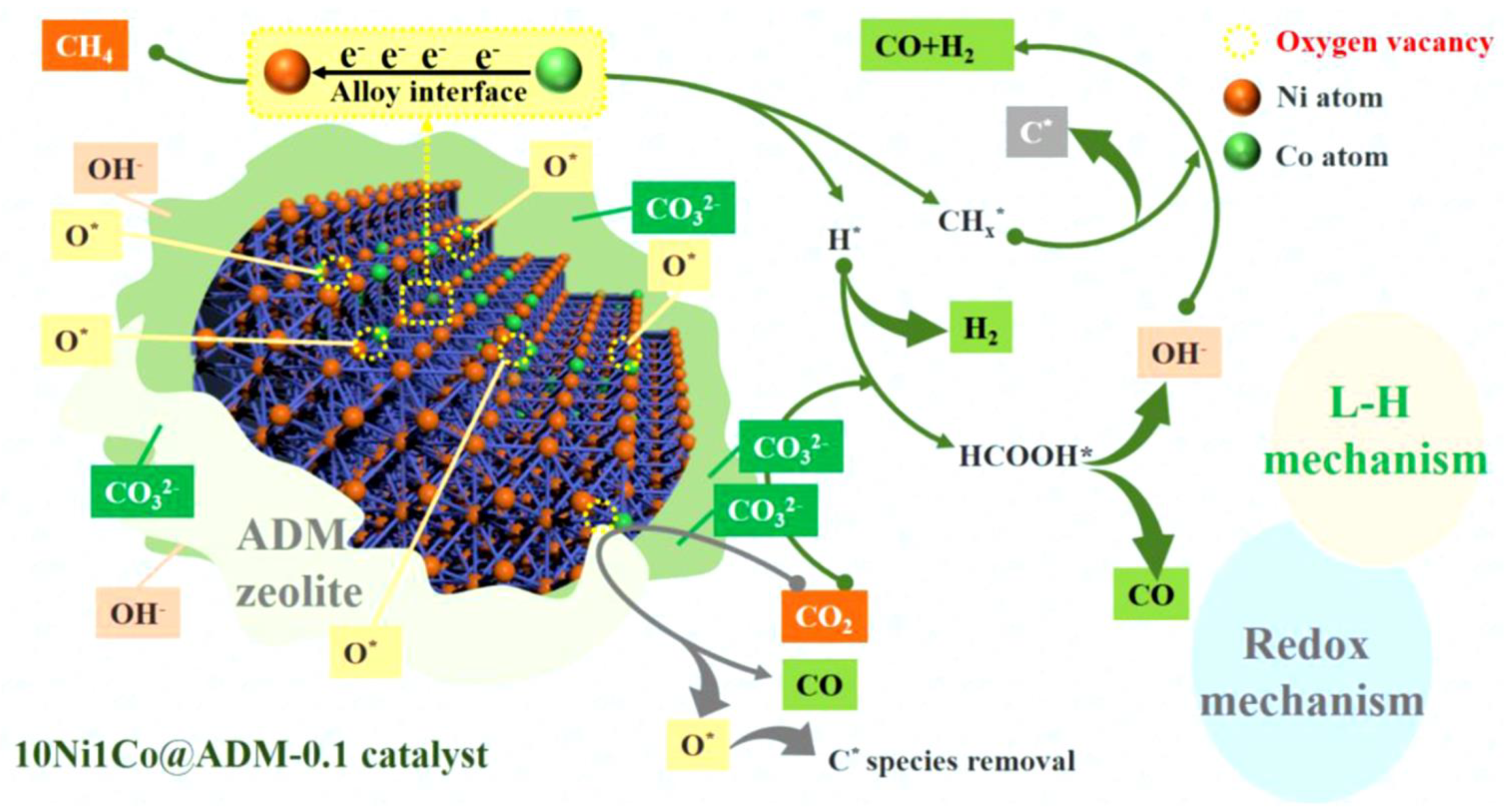
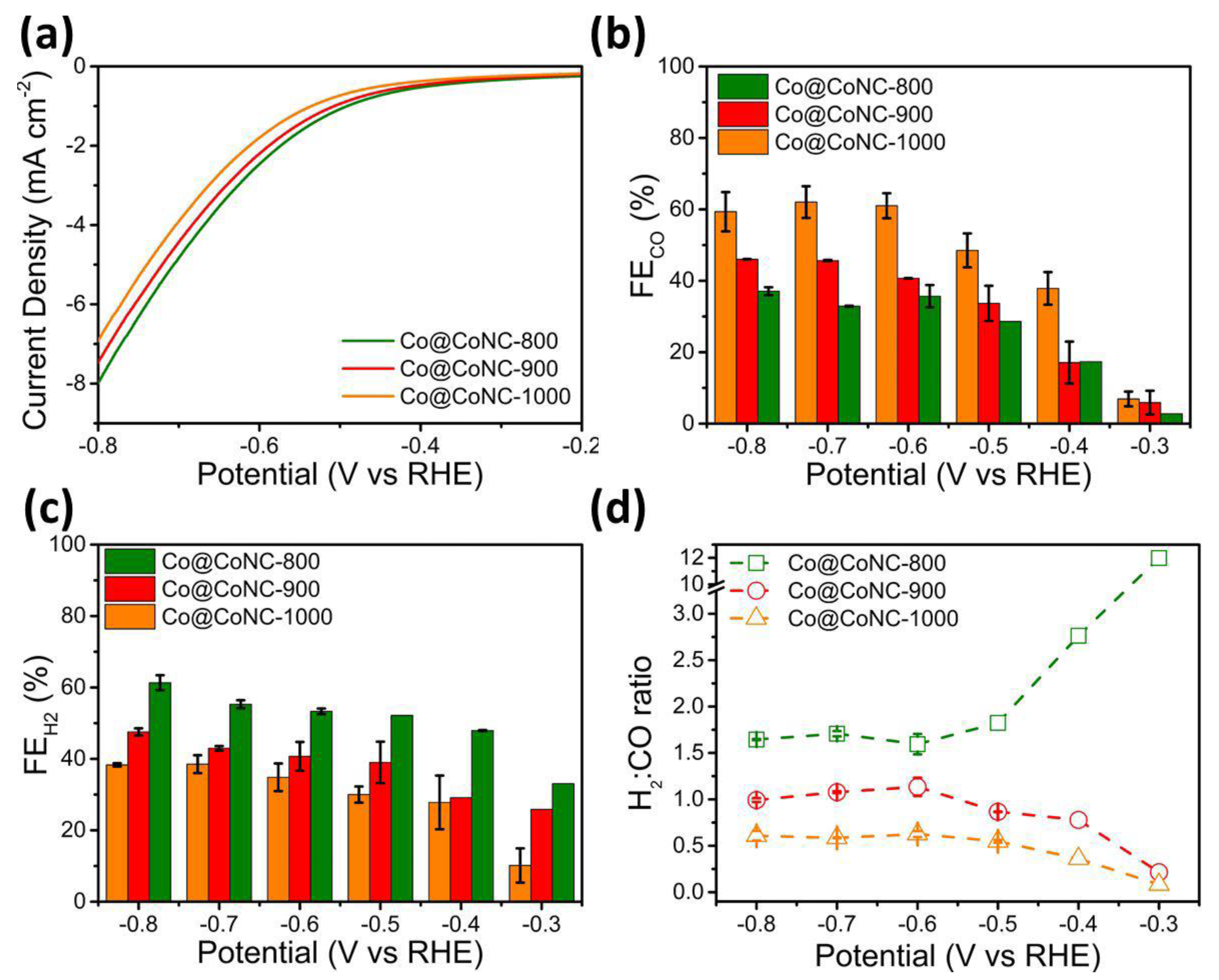

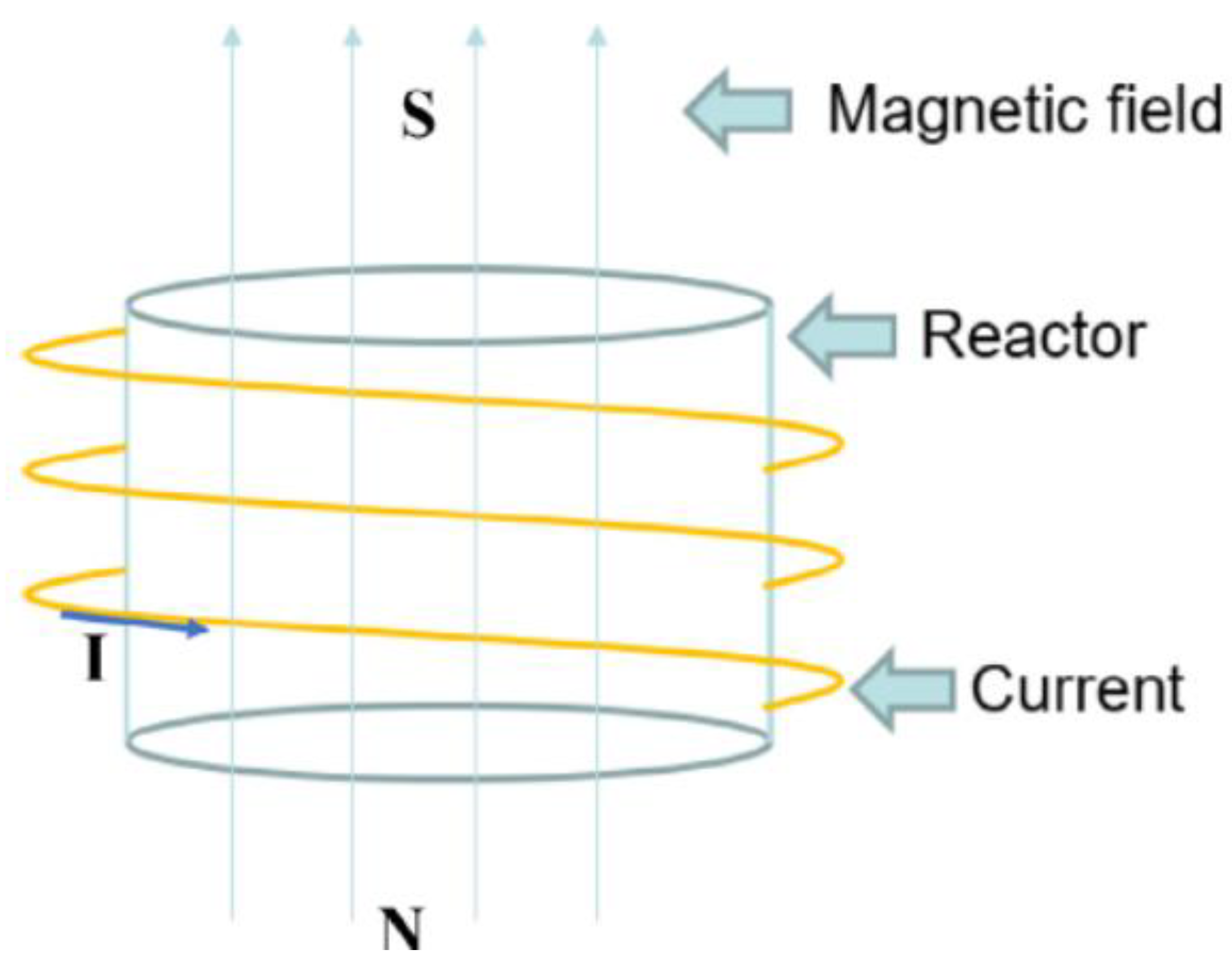
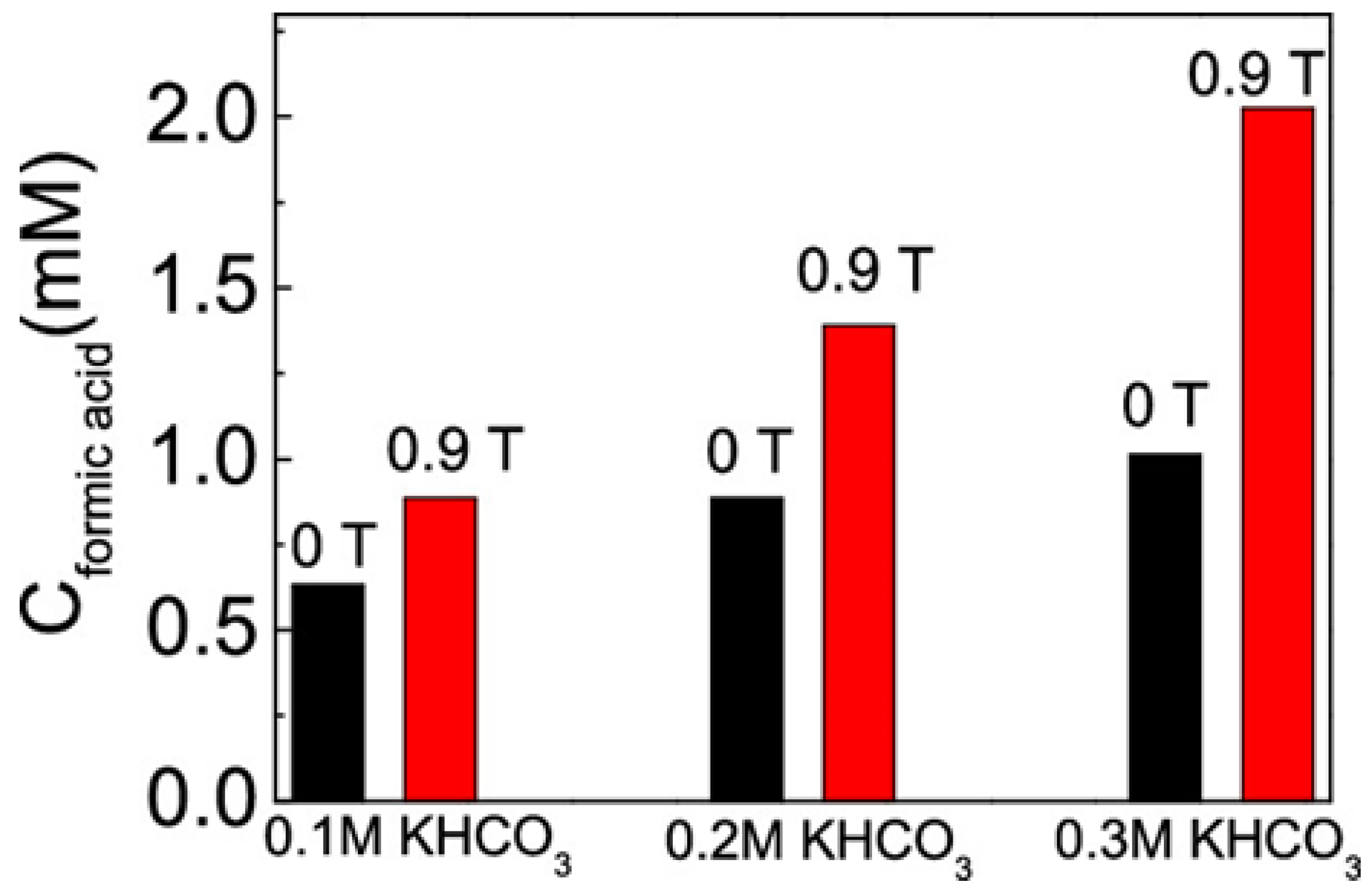
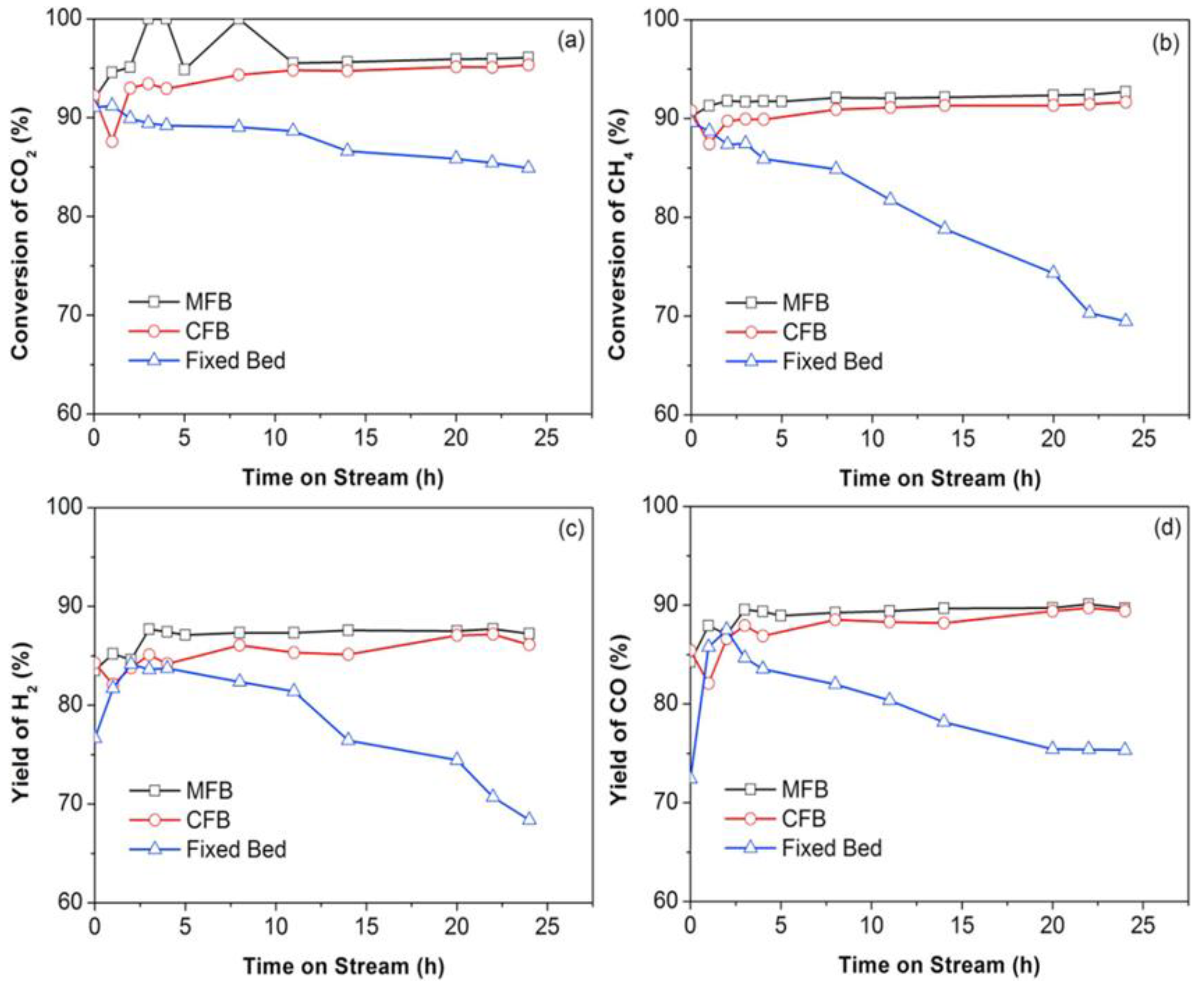
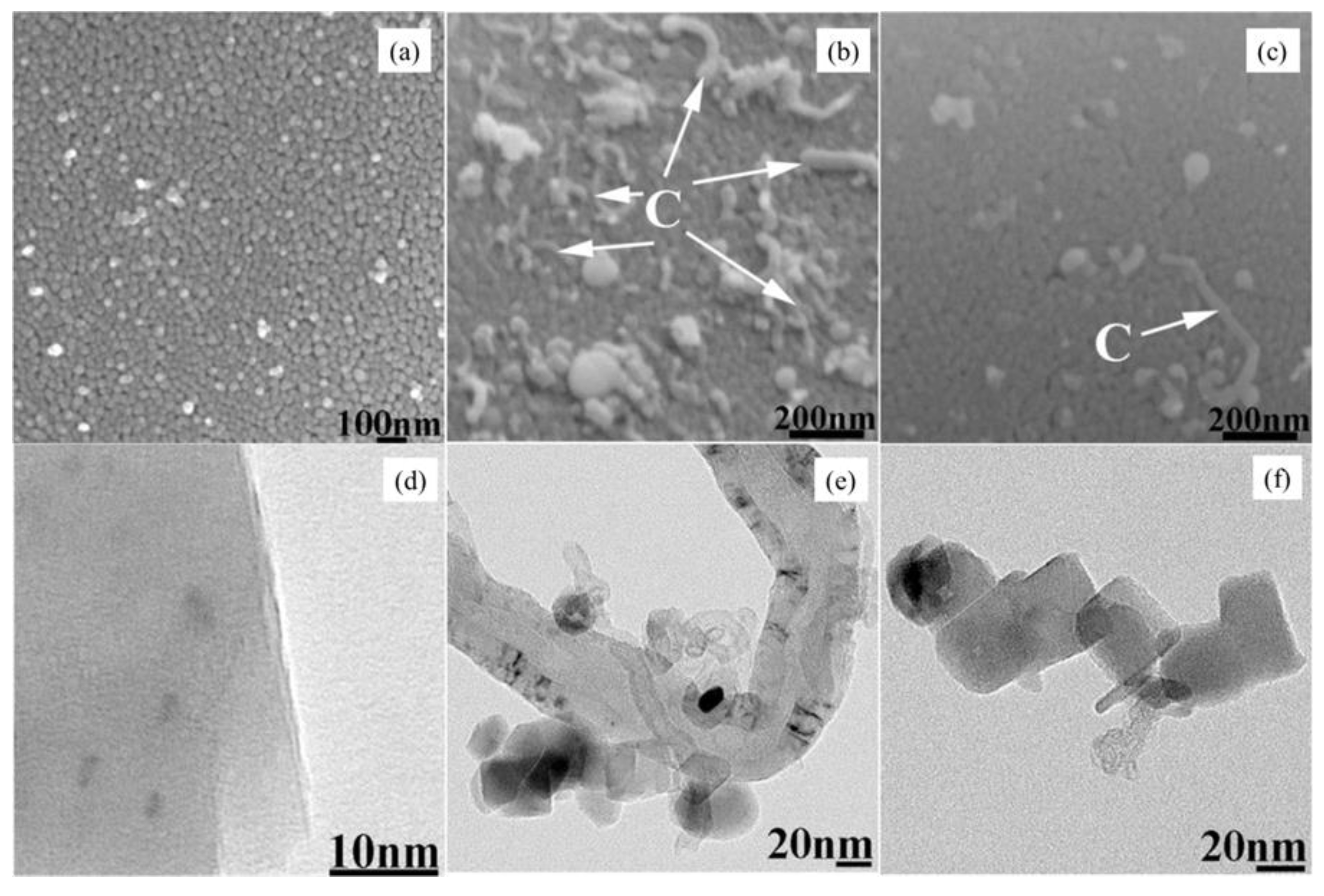
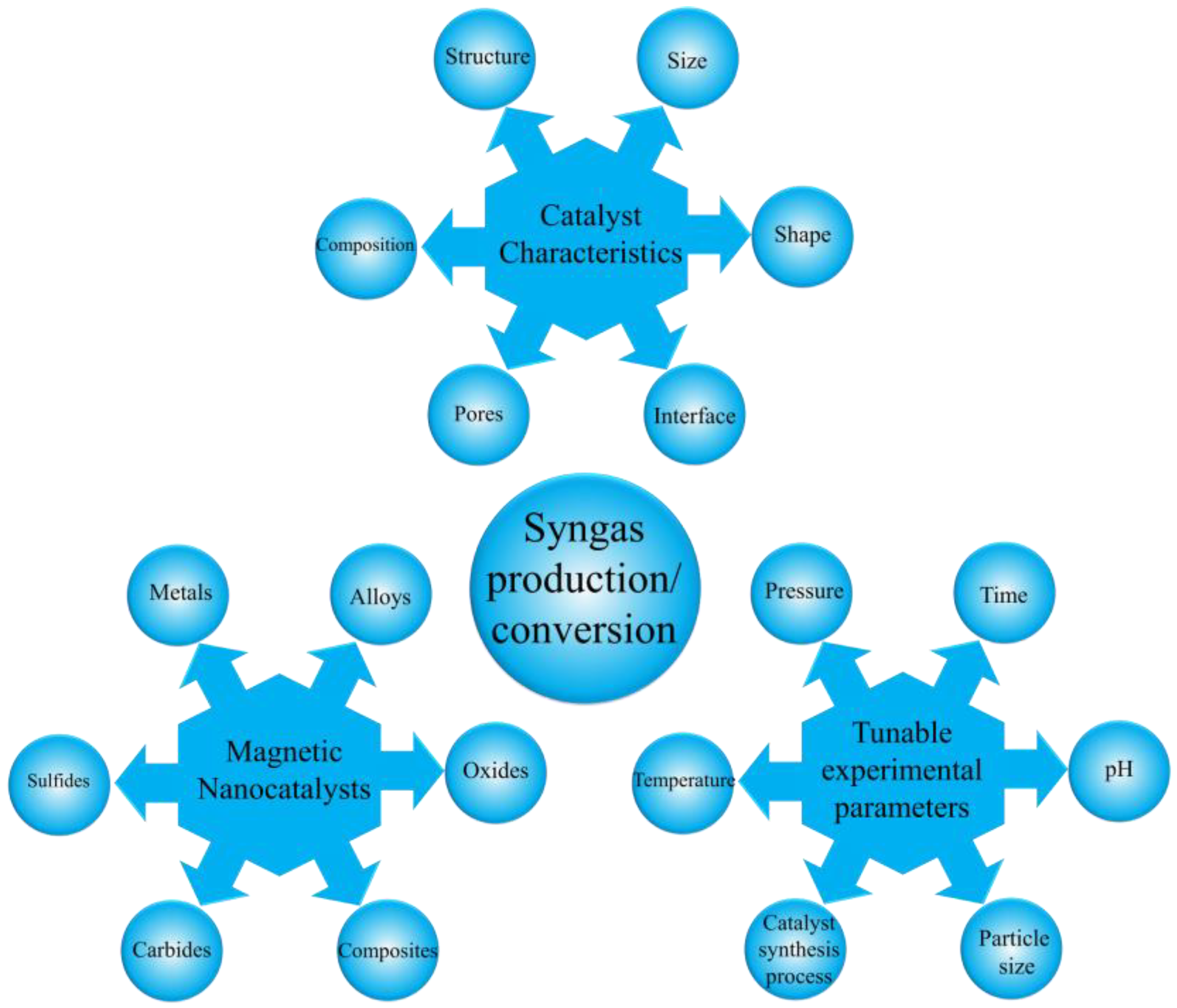
| Magnetic Catalysts | Preparation Process | Process | Performance | Reference |
|---|---|---|---|---|
| MgO/MgFe2 O4 | Combustion process | Biodiesel production reaction from vegetable oil | Lowest conversion is 82.4%, and maximum conversion is 91.2%. | [83] |
| Ni-Fe | Power-to-gas (hydrogenation method) | CO2 methanation | Conversion of 80% of CO2 to methane at 150 °C. CH4 selectivity of CO2 methanation is 95%. | [84] |
| (Fe, Cu, and K) and rice husk char | Pyrolysis method | Catalytic tar conversion for improving the yield of syngas | The tar conversion efficiency is obtained at 77.1% for RHC, 82.7% for K-RHC, and for 92.6% Fe-RHC at the reforming temperature of 800 °C. | [85] |
| FeSo4 | Steam gasification and pyrolysis process | H2-rich syngas production | The maximum overall H2 yield and exergy efficiency for producing H2 are estimated to be 43.63%. | [86] |
| Ni/A-A-CFA | Biogas dry reforming method | Syngas production | It exhibits the best catalytic activity at CH4 and CO2 conversion rate > 95%. | [87] |
| Fe2O3/Al2O3 | Chemical looping dry reforming process | For CO2 production of hydrogen and syngas | Dry reforming stage for CH4 conversion is 3.84, and syngas yield is 98.32%. | [88] |
| TiO2/Fe | Fermentation process | For biohydrogen production | Yield increases by 24.9%. | [89] |
| Fe3O4 and Fe5O12 | Hydrolysis | Biomass production | A 90% harvesting efficiency is obtained. | [90] |
| Fe3O4/CuO | Coprecipitation method | Decolorization of water | A high dye removal efficiency of 94 % is achieved with 20 wt% Fe3O4/CuO composition at ambient conditions and a reaction time of 90 min. | [91] |
| Ni, Ni-Co, Ni-Fe, and Ni-Cu | Hydrothermal synthesis | Syngas production and carbon bio nanofilament | The highest sustainability factor (0.66) and carbon yield (424%) are obtained. | [17] |
| Ni/Al | Coprecipitation method | Production of hydrogen-rich syngas from biomass pyrolysis | Ni/Al-700 catalyst can increase gas yield by 30–80%. | [92] |
| Fe2O3 and MgFe2O | Pyrolysis | Syngas production from biomass | Tar conversion efficiency reaches 94.1% with a high gas yield of 493.5 mL/g. | [93] |
| Fe/CaxO | Simple precipitation method | Pyrolysis - gasification used for syngas production and tar removal | At an optimized composition of Ca/Fe 2/1, gasification yield efficiency (76.4%) is obtained. | [94] |
| Porous Ni, Ni-Co, Ni-Fe, and Ni-Cu | Precipitation method | Biomass decomposition to produce syngas | A high carbon yield efficiency of 36.43% is obtained. | [17] |
| Ni/Al | Ultrasonic-assisted incipient wetness impregnation method | Catalytic conversion of tar to syngas | With the addition of a catalyst, H2 increases to 146%. | [95] |
| Ni-Cu/Al2O3 | Impregnation method | Syngas production by methanol steam reforming | An increase in Ni content results in an increase in CO and a decrease in CO2 yields. | [96] |
| Sc@ Ni/Fe | Pyrolysis method | Impregnation of biomass | At 600 °C, the conversion efficiency reaches 90.07%. | [97] |
| Fe-Ni/CNF | Pyrolysis method | Syngas production from pyrolysis gasification of biomass and plastic waste | Conversion efficiency of 87.90%. | [98] |
| Ni/Ru | Steam reforming process | Ru catalyst favors H2 and CO production | 90% | [99] |
Disclaimer/Publisher’s Note: The statements, opinions and data contained in all publications are solely those of the individual author(s) and contributor(s) and not of MDPI and/or the editor(s). MDPI and/or the editor(s) disclaim responsibility for any injury to people or property resulting from any ideas, methods, instructions or products referred to in the content. |
© 2023 by the authors. Licensee MDPI, Basel, Switzerland. This article is an open access article distributed under the terms and conditions of the Creative Commons Attribution (CC BY) license (https://creativecommons.org/licenses/by/4.0/).
Share and Cite
Chidhambaram, N.; Kay, S.J.J.; Priyadharshini, S.; Meenakshi, R.; Sakthivel, P.; Dhanbalan, S.; Shanavas, S.; Kamaraj, S.-K.; Thirumurugan, A. Magnetic Nanomaterials as Catalysts for Syngas Production and Conversion. Catalysts 2023, 13, 440. https://doi.org/10.3390/catal13020440
Chidhambaram N, Kay SJJ, Priyadharshini S, Meenakshi R, Sakthivel P, Dhanbalan S, Shanavas S, Kamaraj S-K, Thirumurugan A. Magnetic Nanomaterials as Catalysts for Syngas Production and Conversion. Catalysts. 2023; 13(2):440. https://doi.org/10.3390/catal13020440
Chicago/Turabian StyleChidhambaram, Natarajan, Samuel Jasmine Jecintha Kay, Saravanan Priyadharshini, Rajakantham Meenakshi, Pandurengan Sakthivel, Shanmugasundar Dhanbalan, Shajahan Shanavas, Sathish-Kumar Kamaraj, and Arun Thirumurugan. 2023. "Magnetic Nanomaterials as Catalysts for Syngas Production and Conversion" Catalysts 13, no. 2: 440. https://doi.org/10.3390/catal13020440












